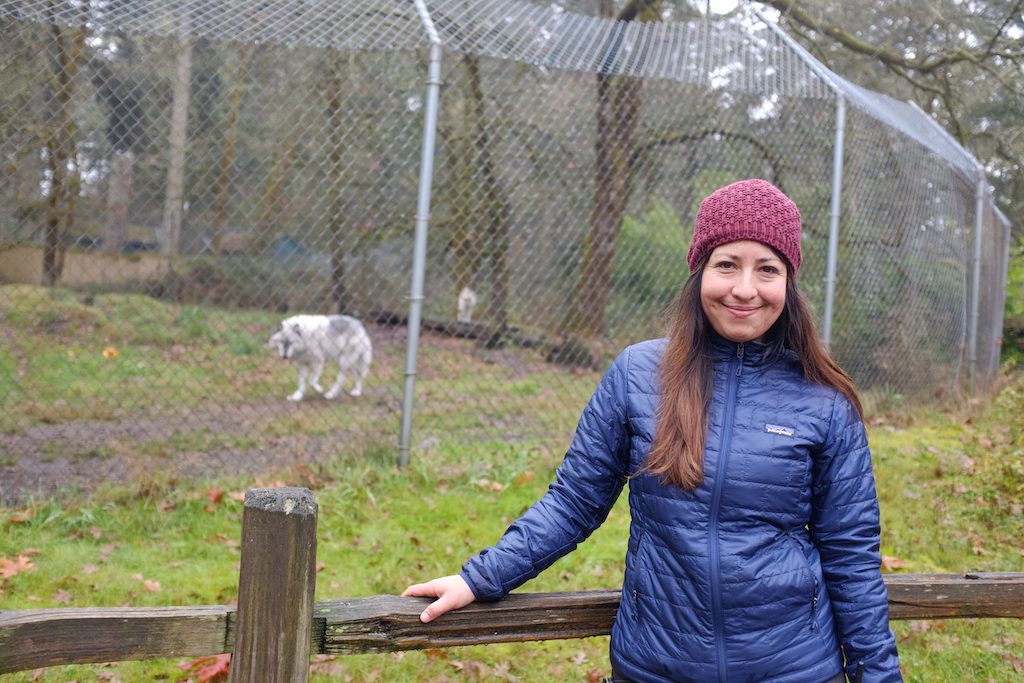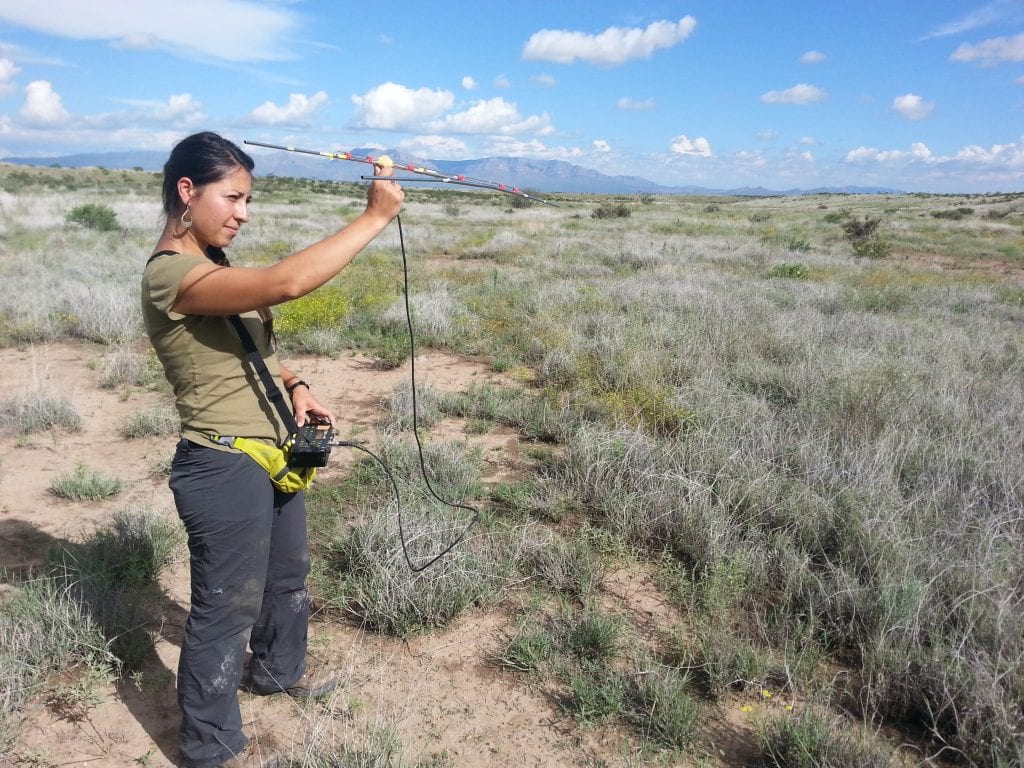Skift Take
Tourists are welcome to visit Wolf Haven International in Washington state, but the needs of the sanctuary's residents — which include two species of wolves, wolf-dogs, and coyotes — are always prioritized. The sanctuary's co-manager Pamela Maciel Cabañas is devoted to making sure that happens.
 Every month Skift will profile someone working in the quirkiest, most incredible and surprising jobs in global travel. Skift's relentless curiosity about our industries extends to every corner of the labor market. Who knew jobs like this even existed?
Every month Skift will profile someone working in the quirkiest, most incredible and surprising jobs in global travel. Skift's relentless curiosity about our industries extends to every corner of the labor market. Who knew jobs like this even existed?
If you plan a visit to Wolf Haven International in Tenino, Washington, there’s a good chance you may see some wolves, but you should know: There is no guarantee.
While a visit without any sightings may sometimes result in a letdown for visitors, that’s by design. Welcoming roughly 10,000 visitors per year, the facility is a sanctuary, not a wild animal park or zoo. According to Wolf Haven sanctuary’s co-manager, Pamela Maciel Cabañas, that means that the animals’ preferences and welfare always comes before human wants and desires. “If the animals want to be seen, it’s their choice.”
It’s a philosophy that runs through all of Maciel Cabañas’ work at Wolf Haven. The facility is home to 55 animals: a mixture of Mexican gray wolves, red wolves, several hybrid wolf-dogs, and two coyotes. Both gray wolves and red wolves have been listed as endangered since the 1970s.
All of the animals were born in captivity. About half are rescues from the pet trade or roadside attractions that will spend their lives at Wolf Haven and be prevented from breeding. The other half are members of what is called a Species Survival Plan. These are captive breeding programs done in conjunction with U.S. Fish and Wildlife Services and the Association of Zoos and Aquariums, an internationally recognized accreditation scheme.
The intent of these programs is to build up a genetically diverse population stock and potentially reintroduce these endangered species in the wild, so they can thrive on their own. Human interaction with the wolves that may be released into the wild are kept to an absolute minimum by animal care staff. The goal is to stop breeding if and when the population can sustain itself.
The Role of Predators
Maciel Cabañas was interested in animals from a very young age. Originally from Mexico, she studied wildlife biology until she graduated and began working with the Mexican wolf recovery program. This eventually led her to Wolf Haven in Washington in 2011. She explained why wolves are a species she’s devoted her career to.
“There’s a lot of ignorance and fear about (predator species), but also they share a lot of resources and habitat with humans — not only habitat, but in the past they have shared also some of the prey,” Maciel Cabañas said, referring to the conflict that occurs when humans take over wolf habitat, and those wolves predictably go on to prey on domesticated animals.
“In the past (wolves) have been persecuted, and there have been government programs to eliminate them. But finally, toward the last part of the last century, they started to understand that all parts are important in a natural system. That they need to protect different groups of these predators, including wolves.”
Adding that wolves are “extremely intelligent” with “very complex social structures in their families, or packs,” Maciel Cabañas said a big part of Wolf Haven’s work is educating its visitors on the importance of keeping wild species, well, wild.
“Every single year we ask ourselves: Are we still doing the best having these visits offered?” Maciel Cabañas said. “We still think we see a great benefit given we respect the needs of the wolf first … (Visitors) get to hear the stories of these animals they have rescued; how they got here; why it is a terrible idea to buy animals that should be in the wild; why it’s a terrible idea to mix them with domestic animals; and why it’s so important to preserve them in the wild.”
Animal Welfare in Tourism
Maciel Cabañas’ average day starts with a walkabout of the facility’s 30 enclosures, which are up to one and a half acres each. The animals are fed five days per week — to mimic short periods of fasting, which is typical in the wild — with food heaved over fences to avoid unnecessary human contact. She also checks on things like the condition of the animals’ sheltered areas, which allow them to hide away from visitors if they so choose, as well as administers any medicine that may be necessary.
Visitors have to schedule their slots, and groups are limited to 20 people at a time. Tours are led by an expert guide, and may be canceled if, say, it’s too hot outside and the wolves would prefer to rest. Wolf Haven gets numerous requests every month from photographers, artists, filmmakers and the like who would like to interact with the wolves up close for various projects. Those are all declined.
It’s a hard thing to communicate in the age of social media — where wild and exotic animals seem ever-closer to us in the form of consumable and adorable content — but generally, these animals do not benefit from close contact with humans. It’s heartening that animal welfare in tourism is being talked about more and more: Airbnb’s new animal tour policy as part of its Experiences product is one example, as is TripAdvisor’s recent expansion of its animal welfare policy, specifically relating to marine animals. But the way most tourists think about the meta human relationship to animals still needs to evolve. And unfortunately, not all sanctuaries are created equal.
Barbara J. King, an expert on animal cognition and emerita professor of anthropology at William & Mary, said that when it comes to wildlife tourism, it’s also important for humans to start thinking about the way their desire to see animals up close affects the welfare of animals themselves.
“The ethics practiced around wild animals across different tourism sites varies immensely, so it’s up to us to take a look online and think hard about what’s right and fair to the animals,” King wrote to Skift in an email, noting that Global Federation of Animal Sanctuaries, which accredits Wolf Haven, has appropriately high standards. “It’s imperative to go beyond the institutional name and what may be its website spin; the gold standard is to visit a place where the animals’ well-being — emotional as well as physical — comes first, always. The tide does turn with public pressure.”
Maciel Cabañas would openly admit that putting animals’ needs first is certainly not great for tourism business. For example, it means making the wolves harder for humans to see by providing hiding places, not breeding captive wolves for the sake of having cuter pups (which visitors love, naturally), and not hosting large or noisy events that may spook the animals yet attract visitors.
But that’s fine. In fact, it’s evident that this ethos is the guiding force of her work.
“Anything we have to make a decision about — whatever it is — we’re going to consider what is best for the animals first.” Maciel Cabañas said. “The sanctuary is for them, not for us.”
The Daily Newsletter
Our daily coverage of the global travel industry. Written by editors and analysts from across Skift’s brands.
Have a confidential tip for Skift? Get in touch
Tags: animals, at your service, tourism, tours and activities, washington
Photo credit: Pamela Maciel Cabañas in front of Shadow's enclosure at Wolf Haven in Washington state. Wolf Haven International

